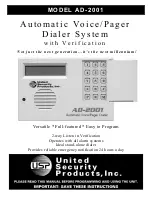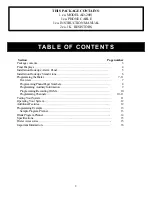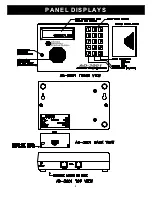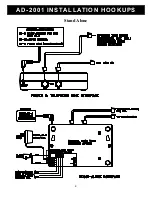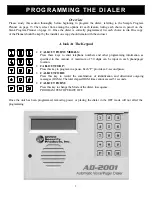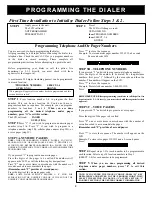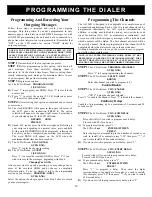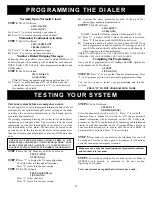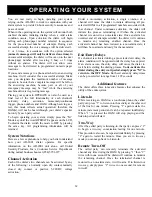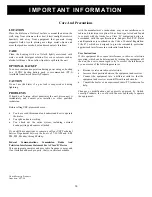
11
Normally Ope n/Normally Closed
STEP 6
The LCD will read:
CH
X
: N.O./N.C.
1(N.O.) 2(N.C.)
A)
Press “1” to select a normally open channel.
B)
Press “2” to select a normally closed channel.
Momentary/Continuous Activation
STEP 7
The LCD will read:
CH
X
: MOM/CONT
1(MOM) 2(CONT)
A)
Press “1” to select a momentary trigger.
B)
Press “2” to select continuous activation.
Numbers Dialed/Outgoing Messages
Following these steps allows you to choose which OGM(s) will
be delivered and which numbers will be dialed for each channel.
NOTE: Dialer LCD will only show programmed numbers and
OGM options.
STEP 8
The LCD will read:
CH
X
: DIAL #X
1(YES) 2(NO)
(“Dial #X” being the number in phone/pager location 1-4)
A)
Press “1” to dial phone/pager #X to be dialed when the
selected channel is activated. Press “2” if you do not wish
this number to be dialed.
B)
Continue the above procedure for each of the up to four
phone/pager numbers programmed in.
STEP 9
The LCD will read:
CH
X
: OGM
X
1(YES) 2(NO)
(“OGM
X
” being the OGM recorded in OGM options #2 - #4)
A)
Press “1” to deliver OGM
X
when the channel is activated.
Press “2” if you do not wish this OGM to be delivered.
B)
Continue the above procedure for each Ch annel/OGM. If you
have programmed in and recorded an ID message as one of
your OGM options, this ID will be delivered to all channels. It
will not appear in the Channel display.
NOTE:
ID AND OGM(S) WILL ONLY BE DELIVERED TO TELEPHONE
NUMBERS, CELLULAR NUMBERS, AND VOICE PAGERS.
Completing The Programming
Once you have programmed in all dialing and OGM options for
each channel, the LCD will read:
ACCEPT
1(YES) 2(NO)
STEP 10
Press “1” to accept the Channel programming. Press
“2” to re-program or to revert to previously programmed setting.
You are now ready to review your programming and test the
system.
PRESS “M” TO EXIT PROGRAMMING MODE.
Test your system before an emergency occurs.
Do not neglect to review programmed information and verify all
elements of your system thoroughly before relying on the dialer
to deliver the necessary information to the desired parties
accurately and completely.
We strongly recommend testing the system in test mode before
connecting to a telephone line. The test mode tests the stored
information, not the full functionality of the dialer. To test the
full functionality of the dialer, the unit must be tested in the
operate mode. In the test mo de, the dialer will not make more
than one attempt per number dialed or play any OGM more than
once.
STEP 1
Press the “M” Mode key until the LCD reads:
TEST: T-LINE
1(YES) 2(NO)
STEP 2
Press “1” to display the T-Line configuration.
The data will scroll through all selections.
Press “2” to scroll to the next section.
STEP 3
The LCD will read:
TEST: CHANNEL(S)
1(YES) 2(NO)
Press “1” to test channels.
Press “2” to scroll to the next section.
STEP 4
The LCD will read:
SELECT: 1-2
3(BOTH) 0(DONE)
Select the channel you wish to test (1-2). Press “3” to test both.
Channels. Once a channel is selected (or “all”) the programmed
channel information will be displayed on the LCD. Verify data
accuracy as the LCD scrolls through by comparing the information
displayed with that specified on your Program Planner. Listen to
your recorded message(s) to ensure that the correct OGM (if
programmed) is delivered. Press “0” to exit testing.
STEP 5
Now connect your dialer to the telephone line you will
be using and test the system again, to determine if it functions
correctly in an actual emergency situation.
STEP 6
To test the operation of your entire system, set Mode to
OPERATE and proceed as explained in the next section:
Operating Your System.
Test your system on a regular basis, at least once a week.
P R O G R A M M I N G T H E D I A L E R
T E S T I N G Y O U R S Y S T E M
NOTE: IF YOU ENTER THE WRONG CHOICE, PRESS “M” KEY
REPEATEDLY AND RETURN TO THE “PROGRAM MODE”, THEN
SELECT THE SECTION TO CHANGE (“1” ACCEPT SECTION, “2”
FOR NEXT SECTION), THEN ENTER CORRECT INFORMATION.
Make sure you notify the receiving party of your intent to call them,
and tell them it is just a test.

